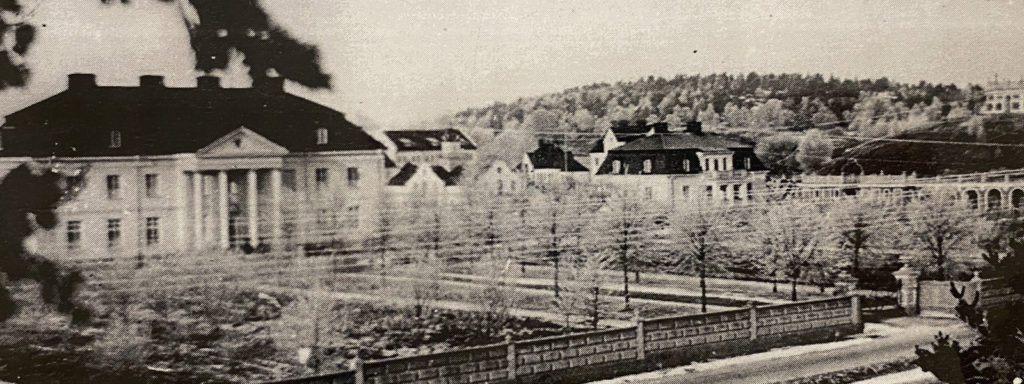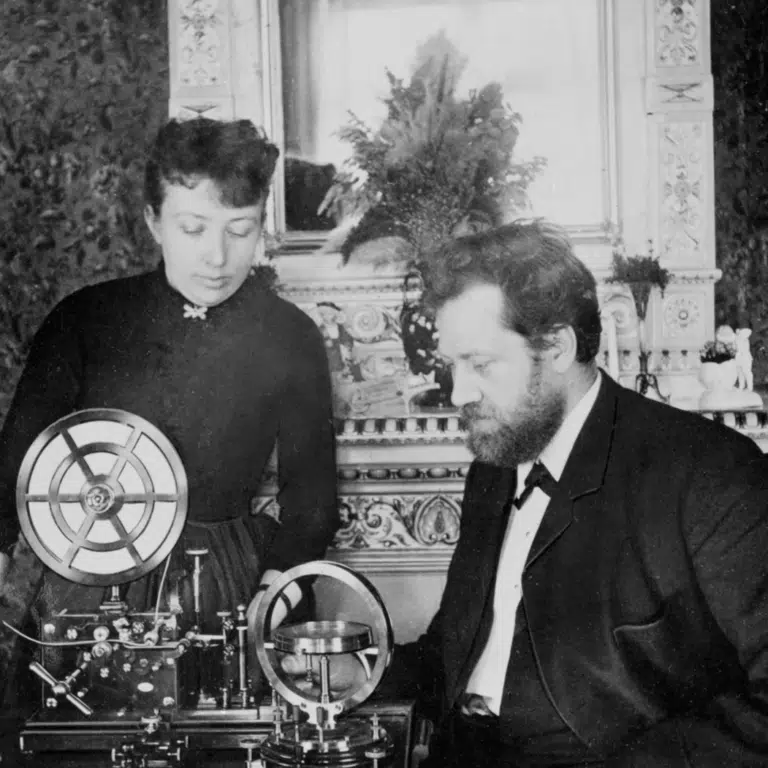The history of Hågelbyparken dates back far, but it was Hilda and Lars Magnus Ericsson who laid the foundation for what is today’s park. They bought Hågelby farm in 1906 and then realized their vision of building a model farm and a modern agriculture.
Almost 700 years ago, on 16 June 1331, someone first mentioned Hågelby in writing, but there were people living here as early as during the Iron Age. Some of what they left behind can still be seen today. Both the runestone at the entrance to the car park and the two burial grounds on each side of the main building are from the Viking Age. Hågelby–Skrävsta’s cultural landscape also has many ancient monuments that show the area was already inhabited 3000 years ago during the Bronze Age.
Lars Magnus and Hilda Ericsson
In 1906, telephone manufacturer and inventor Lars Magnus Ericsson and his wife Hilda bought the Hågelby estate. They set about creating a modern agriculture, growing various crops, fruits and berries. Several of the estate’s buildings were built with reinforced concrete, a novelty in Sweden at the time.
Lars Magnus Ericsson (1846-1926) was a Swedish inventor and entrepreneur, who early on became interested in technology and communication. In 1876, he started Telefonaktiebolaget LM Ericsson, now a multinational company known as Ericsson. Born a farmer’s son in the province of Wermland, Ericsson returned to the countryside when he grew older, first to Alby estate and later to Hågelby estate. Lars Magnus was a true creative mind and it is said that he always walked around on the estate with a pen, paper and a ruler.
Hilda Ericsson (1860-1941) was of great importance to the success and early development of Telefonaktiebolaget LM Ericsson. She created one of Sweden’s most successful companies together with her husband. When Lars Magnus was away on business trips around the world, Hilda ran the business back home in Stockholm. She worked very broadly, with production, accounting, customer relations, negotiations with subcontractors, and was Lars Magnus’ strategic advisor.
Lars Magnus and Hilda are buried in the cemetery at Botkyrka church.
Hågelby house
The main building in the park is an elegant mansion in classicist style. Lars Magnus Ericsson designed many of the farm’s buildings himself, but for the main building he hired the architects Hjalmar Cederström and Uno Borg from Stockholm. The building’s frame is made of brick, but much of the decoration is in concrete. Lars Magnus Ericsson was a great innovator, with telephones as well as construction technology and agriculture.
The gardener’s residence
The gardener’s residence has a round and swirly architecture that differs from the other buildings in the park. This was where the gardener and his staff lived, close to the main building as well as the orchard. This beautiful and symmetrical building shows the high status the gardener carried on the estate. The year 1916 can be seen at the top of the house gables. At the back of the gardener’s residence was a greenhouse, some remains of which can still be seen even today. Below the south wall were lots of hotbeds.
The farm and cultivations
At Hågelby estate, Lars Magnus and Hilda ran a large-scale farm. Their daughter Anna, who was educated in horticulture and had a great interest in cultivation and plants, played a big part in the design of the farm. They planted fruit trees and berry bushes, as well as large flower fields, and grew flax, the Hågelby flax. Near the farms, they built a beehive with room for many hives and bees. The bees naturally contributed greatly to the park’s good harvests.

At the estate was a root vegetable cellar where they stored root vegetables, potatoes and other useful food. They could transport them by horse and carriage over a ”bridge” to drop the harvest into holes leading down into cellar holds from where you could then easily retrieve what you wanted. This bridge is a Sörmland province version of the Rialto Bridge in Venice. Whatever the family did not need for their own household would be sold at Hötorget market in central Stockholm.
Ekotemplet (The Echo Temple), overlooking Aspen lake and parts of the park, was built for relaxation and meditation. The temple is built on a Viking Age burial mound and is said to be a bit magical – if you stand in the middle of it, you can perceive a certain echo even though there are no walls.
The long wall that surrounds Hågelbyparken used to be called the ”Great Wall of China” by the Ericsson family – at its highest point, the wall is over four meters high. It was originally covered in trellis pears, as a part of the farm’s large orchard.
1906 Lars Magnus and Hilda Ericsson buy the Hågelby land plot.
1911-1922 Hågelby estate is designed and built.
1915 Lars Magnus and Hilda Ericsson’s daughter Anna Giertz receives a gift certificate for the property. Her children then own the estate until Botkyrka municipality buys it.
1964 Botkyrka municipality buys the estate.
1975 Hågelbyparken is formed and becomes a ”folkpark” a park available to the public.
1989/2000 Hågelbyparken is named Folkpark of the Year.
2017 Hågelbyparken celebrates 100 years.

